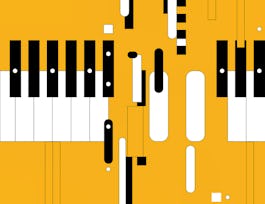In this course you will learn about audio signal processing methodologies that are specific for music and of use in real applications. We focus on the spectral processing techniques of relevance for the description and transformation of sounds, developing the basic theoretical and practical knowledge with which to analyze, synthesize, transform and describe audio signals in the context of music applications.



Audio Signal Processing for Music Applications


Instructors: Xavier Serra
Sponsored by ITC-Infotech
57,928 already enrolled
(289 reviews)
Skills you'll gain
Details to know
10 assignments
See how employees at top companies are mastering in-demand skills

There are 11 modules in this course
Introduction to the course, to the field of Audio Signal Processing, and to the basic mathematics needed to start the course. Introductory demonstrations to some of the software applications and tools to be used. Introduction to Python and to the sms-tools package, the main programming tool for the course.
What's included
11 videos1 reading1 assignment1 programming assignment
The Discrete Fourier Transform equation; complex exponentials; scalar product in the DFT; DFT of complex sinusoids; DFT of real sinusoids; and inverse-DFT. Demonstrations on how to analyze a sound using the DFT; introduction to Freesound.org. Generating sinusoids and implementing the DFT in Python.
What's included
6 videos1 reading1 assignment1 programming assignment
Linearity, shift, symmetry, convolution; energy conservation and decibels; phase unwrapping; zero padding; Fast Fourier Transform and zero-phase windowing; and analysis/synthesis. Demonstration of the analysis of simple periodic signals and of complex sounds; demonstration of spectrum analysis tools. Implementing the computation of the spectrum of a sound fragment using Python and presentation of the dftModel functions implemented in the sms-tools package.
What's included
7 videos1 reading1 assignment1 programming assignment
STFT equation; analysis window; FFT size and hop size; time-frequency compromise; inverse STFT. Demonstration of tools to compute the spectrogram of a sound and on how to analyze a sound using them. Implementation of the windowing of sounds using Python and presentation of the STFT functions from the sms-tools package, explaining how to use them.
What's included
6 videos1 reading1 assignment1 programming assignment
Sinusoidal model equation; sinewaves in a spectrum; sinewaves as spectral peaks; time-varying sinewaves in spectrogram; sinusoidal synthesis. Demonstration of the sinusoidal model interface of the sms-tools package and its use in the analysis and synthesis of sounds. Implementation of the detection of spectral peaks and of the sinusoidal synthesis using Python and presentation of the sineModel functions from the sms-tools package, explaining how to use them.
What's included
8 videos1 reading1 assignment1 programming assignment
Harmonic model equation; sinusoids-partials-harmonics; polyphonic-monophonic signals; harmonic detection; f0-detection in time and frequency domains. Demonstrations of pitch detection algorithm, of the harmonic model interface of the sms-tools package and of its use in the analysis and synthesis of sounds. Implementation of the detection of the fundamental frequency in the frequency domain using the TWM algorithm in Python and presentation of the harmonicModel functions from the sms-tools package, explaining how to use them.
What's included
7 videos1 reading1 assignment1 programming assignment
Stochastic signals; stochastic model; stochastic approximation of sounds; sinusoidal/harmonic plus residual model; residual subtraction; sinusoidal/harmonic plus stochastic model; stochastic model of residual. Demonstrations of the stochastic model, harmonic plus residual, and harmonic plus stochastic interfaces of the sms-tools package and of its use in the analysis and synthesis of sounds. Presentation of the stochasticModel, hprModel and hpsModel functions implemented in the sms-tools package, explaining how to use them.
What's included
8 videos1 reading1 assignment1 peer review
Filtering and morphing using the short-time Fourier transform; frequency and time scaling using the sinusoidal model; frequency transformations using the harmonic plus residual model; time scaling and morphing using the harmonic plus stochastic model. Demonstrations of the various transformation interfaces of the sms-tools package and of Audacity. Presentation of the stftTransformations, sineTransformations and hpsTransformations functions implemented in the sms-tools package, explaining how to use them.
What's included
9 videos1 reading1 assignment1 peer review
Extraction of audio features using spectral analysis methods; describing sounds, sound collections, music recordings and music collections. Clustering and classification of sounds. Demonstration of various plugins from SonicVisualiser to describe sound and music signals and demonstration of some advance features of freesound.org. Presentation of Essentia, a C++ library for sound and music description, explaining how to use it from Python. Programming with the Freesound API in Python to download sound collections and to study them.
What's included
6 videos1 assignment1 peer review
Audio signal processing beyond this course. Beyond audio signal processing. Review of the course topics. Where to learn more about the topics of this course. Presentation of MTG-UPF. Demonstration of Dunya, a web browser to explore several audio music collections, and of AcousticBrainz, a collaborative initiative to collect and share music data.
What's included
6 videos1 reading1 assignment
What's included
3 peer reviews
Instructors


Why people choose Coursera for their career




Learner reviews
289 reviews
- 5 stars
87.88%
- 4 stars
8.99%
- 3 stars
1.73%
- 2 stars
0.69%
- 1 star
0.69%
Showing 3 of 289
Reviewed on Jun 4, 2017
Excellent course, for me this was pitched at just the right level to be interesting and also challenging. Everything was well explained and well structured.
Reviewed on Aug 20, 2021
Very good course. But I think there are not many people studying this course now, so it is difficult to find others to review my peer assignments. Thank all people working for this course!
Reviewed on Feb 4, 2017
Very well presented and thorough investigation into spectrogram, STFT and reconstruction techniques. Enjoying thanks.
Recommended if you're interested in Computer Science

The University of Edinburgh

West Virginia University

California Institute of the Arts

University of London

Open new doors with Coursera Plus
Unlimited access to 10,000+ world-class courses, hands-on projects, and job-ready certificate programs - all included in your subscription
Advance your career with an online degree
Earn a degree from world-class universities - 100% online
Join over 3,400 global companies that choose Coursera for Business
Upskill your employees to excel in the digital economy




